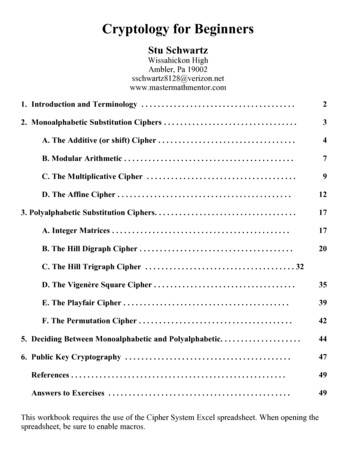
Transcription
Cryptology and Physical Security: Rights Amplification inMaster-Keyed Mechanical LocksMatt BlazeAT&T Labs – Researchmab@crypto.com, mab@research.att.comPREPRINT — 15 Sept 2002 (Revised 2 March 2003). A version of this paper will appear inIEEE Security and Privacy, March/April 2003. The authoritative URL for this document ishttp://www.crypto.com/papers/mk.pdfAbstractThis paper examines mechanical lock security from the perspective of computer science and cryptology. We focus on new and practical attacks for amplifying rights in mechanical pin tumbler locks. Givenaccess to a single master-keyed lock and its associated key, a procedure is given that allows discovery andcreation of a working master key for the system. No special skill or equipment, beyond a small numberof blank keys and a metal file, is required, and the attacker need engage in no suspicious behavior at thelock’s location. Countermeasures are also described that may provide limited protection under certaincircumstances. We conclude with directions for research in this area and the suggestion that mechanicallocks are worthy objects for study and scrutiny.1 IntroductionIn the United States and elsewhere, mechanical locks are the most common mechanisms for access controlon doors and security containers. They are found in (and guard the entrances to) the vast majority ofresidences, commercial businesses, educational institutions, and government facilities, and often serve asthe primary protection against intrusion and theft.As important as locks are in their own right, their design and function has also influenced much of howwe think about security generally. Computer security and cryptology borrow much of their language andphilosophy from metaphors that invoke mechanical locksmithing. The concept of a “key” as a small secretthat allows access or operation, the notion that system security should be designed to depend only on thesecrecy of keys, and even the reference to attackers as “intruders,” can all be traced back to analogies thatlong predate computers and modern cryptology.Conversely, the design of mechanical locks could well be informed by the philosophy and methodologyof computer security and cryptology. For example, formal notions of the computational complexity andother resources required to attack a system could be applied to the analysis and design of many aspectsof mechanical locks. In general, however, these concepts have not enjoyed widespread adoption by locksmiths or lock designers. Computer security specialists, for their part, are often surprisingly unskeptical inevaluating claims of physical security.This paper examines the security of the common master-keyed pin tumbler cylinder lock against aninsider threat model more commonly associated with computing systems: unauthorized rights amplification.As we shall see, not only is this threat of practical concern in physical security, there are simple attacks thatrender many real-world lock systems quite vulnerable to it.1
2 Background: Mechanical LocksA complete review of lock technology is well beyond the scope of this paper. For an excellent discussionof physical security design and evaluation, the reader is referred to [4]. For the purposes of consistentterminology, a brief overview follows.Broadly speaking, mechanical locks fall into two general categories: combination locks, which operateupon demonstration of a secret procedure, and keyed locks, which operate with use of a secret token. Combination locks are most frequently used to control access to safes and vaults and on some padlocks; mostcommercial and residential doors and entrances use keyed locks.There are many different keyed lock designs that have been invented and used throughout the industrialage; among currently manufactured schemes there are warded locks, lever tumbler locks, disk tumbler locks,rotary tumbler locks, and dimple key locks. More recently, electronic locks and computer-based access control systems have found application in some commercial environments. By far the most common mediumand high-security mechanical keyed lock mechanism in the U.S. and many other countries, however, is themechanical pin tumbler lock cylinder.2.1 Evaluating Lock SecurityMechanical locks must resist a much wider range of threats than those associated with computing or communications systems.First, of course, locks function in the physical world and must therefore be sufficiently mechanicallystrong to withstand forceful attack. Evaluation of this aspect of lock security focuses on such issues as thestrength of materials, the accessibility of weak points, resistance to various tools, and so forth. There areindustry and government standards that require specific physical characteristics of locks for various applications, which vary depending on the expected resources of the attacker and the likely ease of alternativemethods of entry (e.g., through a broken window).A related issue is the ease with which the locking mechanism itself can be bypassed. It may be possibleto open a lock without interacting with the keyed mechanism at all: door latches can often be wedged orpried open, for example. Here, security depends not only on the lock but also the soundness and correctnessof its installation.It is also possible that a lock might be manipulated to operate without a key or that a key can be fabricated without knowledge of its parameters. The most common (or at least famous) manipulation methodinvolves picking, which exploits small manufacturing imperfections and mechanical tolerances to set a lockto a keyed state without using a key. A related method, impressioning, fabricates a working key directly.Manipulation is generally non-destructive and may leave behind only minimal external evidence. Both picking and impressioning require finesse and skill, however, and are much more difficult to carry out againstlocks of better quality, especially designs that employ security features intended specifically to thwart manipulation.Evaluating and protecting against most of the above threats focuses more on the details of a lock’smechanical and physical construction than on abstractly quantifiable security metrics. A computer scienceand cryptologic security analysis, on the other hand, might take a more abstract, idealized view of locks andtheir operation. In particular, we might be especially concerned with the security of the key space againstvarious threats.The most basic design goal of all keyed locks is that a correct key is required for operation; ideally, itshould not be possible to operate a lock without possession of the key. (This is rarely achieved in practicedue to the factors discussed above, but that is not critical for the purposes of this discussion). Amongthe most quantifiable security parameters for discussing locks, therefore, is the number of possible uniquekeys (called the number of differs or changes in the terminology of the trade), which gives the probability2
Figure 1: A pin tumbler lock cylinder. Left: The cylinder face. Note the keyway, which is cut into the plug,which in turn sits inside the shell. Right: Side view, with part of the shell and plug cut away to expose thesix pin stacks. Note the border between the plug and shell, which forms the shear line, and the cuts in eachpin stack resting within the plug.that a randomly cut key will operate a given lock and an upper bound on the resources required to find aworking key by exhaustive search. On typical commercial locks, there are between several thousand andseveral million possible distinct keys. While these numbers may seem very small by computational securitystandards, mechanical locks perform on a more human scale. Testing a key against a lock, after all, is an“online” operation requiring seconds, not microseconds, and carries with it at least some risk of discoveryif the lock is not one to which the attacker has legitimate access.If exhaustive search is not feasible, it may still be possible to analyze and exploit a lock’s key space inother ways.2.2 The Pin Tumbler LockThe modern pin tumbler lock is quite simple, dating back to ancient Egypt but not commercially massproduced until the middle of the 19th century. The basic design consists of a rotatable cylinder tube, calleda plug, that operates the underlying locking mechanism. Around the circumference of the plug is a shell,which is fixed to the door or container. Rotation of the plug within the shell operates the locking mechanism.In the locked state the plug is prevented from rotating by a set of movable pin stacks, typically under springpressure, that protrude from holes in the top of the opening in the shell into corresponding holes drilled intothe top of the plug. Each pin stack is cut in one or more places perpendicular to its length. See Figure 1. (Inpractice, the cuts are produced by stacking pin segments of particular sizes, not by actually cutting the pins;hence the term “pin stack.”)With no key in the lock, all the pin stack cuts rest within the plug. When a key is inserted into the keywayslot at the front of the plug, the pin stacks are raised within the plug and shell. The plug can rotate freelyonly if the key lifts every pin stack’s cut to align at the border between the plug and shell. The plug/shellborder is called the shear line. See Figure 2. The plug will be blocked from rotating if any pin stack is liftedeither not far enough (with the cut still in the plug below the shear line) or too far (with the cut pushed abovethe shear line and into the shell); to rotate, all pin stacks must have a cut at the shear line. See Figure 3.The height (or cut depth) of a key under each pin stack position is called its bitting; the bitting of a key isthe “secret” needed to open a lock. A key that is bitted to the wrong depth in even one pin position will notallow the lock to operate.Generally, a lock manufacturer will choose from among only a small number of standard bitting depthsat each pin position. This allows keys to be described concisely: typically, the bitting depth number is3
Figure 2: Pin tumbler lock with a correct key inserted. Left: The correct key lifts the pin stacks to align thecuts at the shear line. Right: With all of the cuts at the shear line, the plug can rotate freely within the shell.Here the plug has been turned slightly toward the camera, so that the tops of the pins in the plug are visible.Figure 3: A lock with an incorrect key. Observe that while three of the pin stacks’ cuts are at the shear line,two stacks have the cut too high and one stack has the cut too low.4
written starting from the shoulder (handle) of the key to the tip, giving the standard depth number at eachposition. So a key for a five pin lock denoted “12143” would be cut to depth “1” nearest the shoulder,and proceeding toward the tip cut at depths “2,” “1,” “4” and “3.” (The exact specifications of the depthsand positions for most commercial locks are widely published in the trade or could be discovered easily bydisassembling a sample lock or measuring a small number of cut keys.) Typically, the number of pins is inthe range of four to seven, and the number of possible depths ranges from four to ten, depending on the lockmodel. Better quality locks generally employ more pins and use more distinct cut depths on each.Pin tumbler locks can often be defeated in various ways, although a discussion of lock picking andother bypass techniques that require specialized skills or tools or that exploit mechanical imperfections isbeyond the scope of this paper. In practice, however, even very modest products are often sufficiently secure(or offer the perception of being sufficiently secure) to discourage the more casual would-be intruder fromattempting to operate a lock without a key. Probably the most commonly used techniques for unauthorizedentry, aside from brute force, involve procuring a working key.2.3 Master KeyingComplicating the analysis of pin tumbler lock security is the fact that, especially in larger-scale installations,there may be more than one key bitting that operates any given lock. The most common reason for thisphenomenon is the practice of master keying, in which each lock in a group is intended to be operated notonly by its own unique key (the change key in trade parlance) but also by “master” keys that can also operatesome or all other locks in the system.Master keying in pin tumbler locks can be accomplished in several ways, with the earliest systems datingback over 100 years. The conceptually simplest master key method entails two cylinders on each lock, onekeyed individually and the other keyed to the master bitting; a mechanical linkage operates the lock wheneither cylinder is turned. Other master keying schemes employ an independently keyed master ring aroundthe lock plug, and still others depend on only a subset of pin positions being used in any given lock. All ofthese approaches have well-known advantages and disadvantages and are not considered in this paper. Mostimportantly, these schemes require the use of special locks designed specifically for master keying.The most common master keying scheme – the subject of consideration of this paper – can be used withvirtually any pin tumbler lock. Recall that in an ordinary, non-mastered pin tumbler lock, each pin stack iscut in one place, defining exactly one depth to which the stack must be lifted by the key bitting to align withthe shear line. In the conventional split pin mastering scheme, however, some or all pin stacks are cut inmore than one place (typically in two places), allowing additional bittings that align such pins. See Figure4.Consider for example, a lock A, which has five pin stacks with four possible cut positions in each.Suppose pin stacks 1 through 5 are each cut in two places, corresponding to bittings “1” and “4”. Observethat this lock can be opened by at least two keys, one with bitting 11111 and another with bitting 44444.We could create a second lock B, this time with pin stacks 1 through 5 each cut at depth “2” and depth “4”.This lock can be operated by keys cut 22222 and 44444. If these are the only two locks in the system, keys11111 and 22222 can be said to be the change keys for locks A and B, respectively, while key 44444 is amaster key that operates both.There are a number of different schemes for master keying; the subject is surprisingly subtle and complex, and the trade has developed standardized practices in recent years. For in-depth treatments, the readeris referred to [1] and [2].For the purposes of our discussion it is sufficient to note that modern split-pin master systems are keyedaccording to one of two standard schemes, called Total Position Progression (TPP) and Rotating Constant(RC). In TPP schemes, every pin stack has a single separate master cut, which is never used in that positionon any change keys. In RC schemes, change keys do share the master bitting for a fixed number of pin stack5
Figure 4: A master keyed pin tumbler lock. Left: Each of the six pin stacks has two cuts. Right: With thecorrect change key inserted, one of the cuts on each pin stack is aligned at the shear line. Observe that theother cut is sometimes above and sometimes below the shear line.positions, although the positions will vary (rotate) from lock to lock. Both these schemes can implementa directed graph with several levels of master keys: “sub-master” keys that open a subset of locks in thesystem and “grand master” keys that open more 1 . The highest-level master key, which opens all locks in amulti-level system, is sometimes called the Top Master Key (TMK).Master keying has long been understood to reduce security in several important ways. First, of course,the master key represents a very valuable target; compromise of the master key compromises the entiresystem. Even if the master keys are well protected, security is still somewhat degraded. Because eachmastered pin stack aligns with the shear line in several positions, mastered systems are more susceptible tocross keying and unintentional key interchange, in which keys from the same or other systems operate morelocks than intended. For the same reason, mastered locks tend to be more vulnerable to manipulation bypicking and impressioning. These weaknesses can be mitigated to some extent through careful planning,improved mechanical construction, and the use of additional pin stacks and possible cut depths.In this paper, however, we consider methods for discovering the master key bitting in conventional pintumbler systems given access to a single change key and its associated lock. No special skills or tools arerequired on the part of the attacker, nor is it necessary to disassemble any lock or engage in any inherentlyconspicuous or suspicious activity. We also suggest countermeasures and alternative lock designs that canfrustrate these attacks to at least some extent under certain circumstances.3 Rights Amplification: Reverse-Engineering Master KeysClearly, the most valuable, sensitive secret in any lock system is the bitting of the top-level master key(TMK). Insiders, who possess legitimate change keys and have physical access to locks, represent perhapsthe most serious potential threat against master keyed systems. The primary purpose of assigning locksunique change key bittings, after all, is to allow operating privileges to be granted to only specific locks; ifa change key can be converted into a master key, a major security objective of the system is compromised.In the terminology of computer security, master key systems should resist unauthorized rights amplification(also called privilege escalation). Unfortunately, most deployed master key systems are quite vulnerable inthis regard.1There are also Selective Key systems, in which any lock can be keyed to operate with an arbitrary subset of keys, usingtechniques similar to master keying, and Maison Key schemes, in which certain locks are keyed to all keys in a group. We do notconsider such systems here.6
3.1 BackgroundSeveral time-honored methods convert change keys into master keys, with different techniques applicabledepending on the particular system and resources available to the attacker.The simplest approach to master key discovery involves direct decoding of an original master key, e.g.,from visual inspection, photographs, photocopies, or measurement. A trained observer may be able to recallthe cut depths with surprising accuracy after being allowed to look only briefly at a key.Another direct technique involves disassembly of a master keyed lock and measurement of the pins ineach pin stack to determine the bittings that will operate each pin position. Without access to the lock’schange key, this does not yield complete information about the master bitting; there will be exponentiallymany potential master key bittings, only one of which will correspond to the true master key. If every pin is mastered according to a standard TPP scheme, disassembly of a single lock will revealpotential masterkeys, where is the number of pin stacks. (This exponent is still small enough to make exhaustive search ofthese keys feasible in many cases). Disassembly of additional locks from the same system can narrow thissearch space significantly. If the change key to a disassembled lock is available, the cuts corresponding to itsbitting can be eliminated from each pin stack, making the correct bitting of the true master unambiguouslyclear from a single sample. (More secure lock designs make it difficult to non-destructively remove a lockwithout the key, e.g., by placing set screws in locations that are inaccessible when a door is closed andlocked). Padlocks are especially vulnerable to these sorts of attacks, since they can be stolen easily whenthey are left unlocked.A sufficiently large group of change key holders in TPP-based systems may be able to reverse engineera master key without disassembling any locks. Recall that in these systems change keys never have thesame bitting at a given pin position as the master. By measuring their change keys, a conspiracy of keyholders may discover a single depth not used at each pin position on the change keys; this will correspondto the master bitting. Several correspondents have noted that this technique is occasionally employed byenterprising university students, especially at better engineering schools.None of these approaches is completely satisfactory from the point of view of the attacker, however.Direct decoding from the true master key entails limited access to such a key and is not possible if nomaster key is available for measurement. Lock disassembly for pin measurement may expose the attackerto suspicion and could be difficult to perform in secret (and carries the risk that the lock may be damagedin reassembly). Comparing a large number of different keys requires, in the first case, a large number ofdifferent keys, which may not be available, and is ineffective against RC-based systems.A more powerful attack requires only one change key and is effective against all standard TPP- and RCbased systems.3.2 An Adaptive Oracle-Based Rights Amplification AttackIt is useful now to consider a lock in more abstract terms. From a cryptologic point of view, we mightobserve that a lock is really an online “oracle” that accepts or rejects keys presented to it. In this sense, theoracle gives a single bit answer for each key presented to it; the lock either turns or it does not.A natural question to ask about any online oracle is whether it is feasible to issue a small number ofqueries that force the oracle to leak its secrets. In particular, can we exploit the oracle to test efficientlysingle “bits” of a possible key or must we exhaustively search the entire key space?Recall that a pin tumbler lock will operate when each of its pin stacks is raised (by a key) to a positionwhere one of its cuts is aligned at the shear line. There is no “communication” among pins; the lock willoperate not only with all pin stacks aligned at the change key depth or all pin stacks at the master key depth,but also by keys that align some stacks at the change depth and others at the master depth. That is, considerour five pin lock A from the previous section, with key bitting 11111 representing A’s change key and 444447
representing the system’s master key. This lock can be operated not only by the obvious keys cut 11111 and44444, but by a total of different keys, including, e.g., 11114, 11141, etc.It is straightforward to exploit this phenomenon to discover the master key bitting given access to asingle change key and its associated lock, plus a small number of blank keys milled for the system keyway.In our new2 attack, we use the operation or non-operation of a lock as an “oracle” to determine, pin bypin, the complete bitting of the TMK.3.2.1Notation Let denote the number of pin stacks in a lock, with stack representing the first stack (e.g., the one closestto the shoulder of the key) and stack representing the last (e.g., the stack at the tip of the key).Let denote the number of distinct key bitting depths in a pin stack, where 1 is the highest bitting (inwhich the pin stack is raised the most) and is the lowest (in which the pin stack is raised the least).Assuming that the physical properties of the system place no restrictions on the bitting depth of adjacent .pin positions, observe that the number of distinct keys is 3.2.2 The Attack For each pin position, from 1 to , preparetest keys cut with the change key bitting at every positionkeys with each possible bitting depth excluding theexcept position . At position , cut each of thebitting of the change key at that position. Attempt to operate the lock (“query the oracle”) with each of thesetest keys, and record which keys operate the lock.In a TPP-based system with every pin mastered, exactly one of thetest keys for each pin positionwill operate the lock; the depth of the test key at that position represents the master bitting at that position.If none of the test keys for a particular position operates the lock, then either that pin is not mastered or itis an RC-based system. In either of these cases, the master key bitting at that position is the same as that ofthe original change key.Once the master bitting has been determined at each of the positions, a complete top-level master keycan be cut easily.key blanks and requires probes of the lock, inObserve that our attack consumes the worst case. If it is possible for the attacker to cut keys between probes of the lock, however, a simpleoptimization reduces the number of blanks consumed to in the worst case. Rather than cuttingseparate blanks per position, the attacker need only use a single key, initially cutting the position under testto the highest depth and re-cutting the same blank successively lower after probing the lock. This reducesthe total cost of carrying out the attack to less than about two US dollars in the worst case. This optimizedprobes of the lock in the worse case, of course.attack still requires 3.2.3Practical Considerations In some lock designs, not all of thepossible keys are “legal”. In particular, with some lock modelsit is not possible on a standard key to have a very high cut immediately adjacent to a very low cut if theangle at which the bittings are cut reaches across to the next pin position. A lock’s Maximum Adjacent CutSpecification (MACS) might require, for example, in a system with 7 different cut depths that adjacent cuts2It is always difficult to be sure that something is novel in the sense of not having previously been discovered independently;the lack of a coherent and open body of literature on locks makes it especially so here. Our attack surely is not new in this sense.Several correspondents have suggested that similar approaches to master key reverse engineering have been discovered and usedillicitly in the past and the method occasionally circulated informally, e.g., on Internet message boards. (We subsequently found amessage originally sent to a private mailing list in 1987 from Doug Gwyn that describes a similar method.) However, there do notappear to be references to this particular attack in the published literature of either the locksmith or underground communities.8
be no more than 4 steps apart, disallowing, for example, keys with a depth “1” cut next to a depth “7” cut.Even if both the change key and the master key do not violate the MACS rule for a particular lock, thisattack employs test keys that mix change key cuts with potential master cuts. If the original change key hasvery high or very low cuts, it may therefore be necessary for the attacker to create some test keys that doviolate MACS. In practice, on the locks we examined with MACS restrictions, it is generally still possibleto cut working test keys by using a steeper than usual angle and with cuts occupying slightly narrower thanusual space on the key. Although insertion and removal of such keys is more difficult, they are sufficientfor this limited (single-use) purpose. Alternatively, previously discovered master depths could be used inadjacent positions on subsequent test keys.Also complicating our attack is the possibility that the master cuts lie somewhere between the “standard”depths ordinarily used by the lock manufacturer. This is more likely in older systems or those keyed byprivate locksmiths who may not follow manufacturer-standardized practices. When this is suspected to bethe case, the attacker must probe the lock at more test cut depths, removing only a small amount of keymaterial (.005 inches or so) from the position under test between probes. (This is similar to the procedureused when creating a key by the “impressioning” technique and could be performed with a fine metal file.)Some systems, especially in older installations, use master cuts that are consistently higher or lower thanthe change key cuts. This practice makes it especially easy to discover the master key with this attack.Multi-level master systems may or may not present a special challenge. In standard TPP and RC systems,every pin stack has at most two cuts; “submasters” are implemented by using a fixed change key bitting oncertain pins for locks within each submaster group. In such cases, the attack proceeds as described andyields the TMK. It is also possible, however, to implement hierarchical submastering by using more thantwo cuts on each pin stack. In such cases the TMK bitting of a given pin may be ambiguous. An attacker candistinguish the true TMK cuts in such systems by conducting the attack on locks from different submastergroups. This may not always be necessary, however. It is common for such systems to employ the conventionthat all of the TMK cuts are either above or below the submaster cuts.Some larger installations put different groups of locks on distinct keyways, such that a change keyfor a lock in one group does not fit into the keyway of locks from others. The TMK is cut on a special“master” blank that fits all the keyways in the system. This practice, called Sectional Mastering or MultiplexMastering, expands the number of effective differs in the system and reduces cross keying between differentlock groups. Sectionally mastered systems are especially attractive targets for attack, since the TMK worksfor a very large number of locks across groups that would otherwise have to be keyed on different mastersystems. The attacker simply cuts the TMK bitting (derived from a lock in any section) onto a blank milledfor the master section.It is worth noting that even “high security” pin tumbler lock designs, including those that use sidebarcuts and rotating pins, are usually in principle vulnerable to this attack; the only question is whether theattacker can obtain or fabricate the required blanks. Furthermore, our attack can be generalized
It is also possible that a lock might be manipulated to operate without a key or that a key can be fab-ricated without knowledge of its parameters. The most common (or at least famous) manipulation method involves picking, which exploits small manufacturing imperfections and mechanical tolerances to set a










